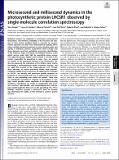Notice
This is not the latest version of this item. The latest version can be found at:https://dspace.mit.edu/handle/1721.1/132195.2
Microsecond and millisecond dynamics in the photosynthetic protein LHCSR1 observed by single-molecule correlation spectroscopy
Author(s)
Kondo, Toru; Gordon, Jesse B; Pinnola, Alberta; Dall’Osto, Luca; Bassi, Roberto; Schlau-Cohen, Gabriela S; ... Show more Show less
DownloadPublished version (870.6Kb)
Publisher Policy
Publisher Policy
Article is made available in accordance with the publisher's policy and may be subject to US copyright law. Please refer to the publisher's site for terms of use.
Terms of use
Metadata
Show full item recordAbstract
© 2019 National Academy of Sciences. All rights reserved. Biological systems are subjected to continuous environmental fluctuations, and therefore, flexibility in the structure and function of their protein building blocks is essential for survival. Protein dynamics are often local conformational changes, which allows multiple dynamical processes to occur simultaneously and rapidly in individual proteins. Experiments often average over these dynamics and their multiplicity, preventing identification of the molecular origin and impact on biological function. Green plants survive under high light by quenching excess energy, and Light-Harvesting Complex Stress Related 1 (LHCSR1) is the protein responsible for quenching in moss. Here, we expand an analysis of the correlation function of the fluorescence lifetime by improving the estimation of the lifetime states and by developing a multicomponent model correlation function, and we apply this analysis at the single-molecule level. Through these advances, we resolve previously hidden rapid dynamics, including multiple parallel processes. By applying this technique to LHCSR1, we identify and quantitate parallel dynamics on hundreds of microseconds and tens of milliseconds timescales, likely at two quenching sites within the protein. These sites are individually controlled in response to fluctuations in sunlight, which provides robust regulation of the light-harvesting machinery. Considering our results in combination with previous structural, spectroscopic, and computational data, we propose specific pigments that serve as the quenching sites. These findings, therefore, provide a mechanistic basis for quenching, illustrating the ability of this method to uncover protein function.
Journal
Proceedings of the National Academy of Sciences of the United States of America
Publisher
Proceedings of the National Academy of Sciences